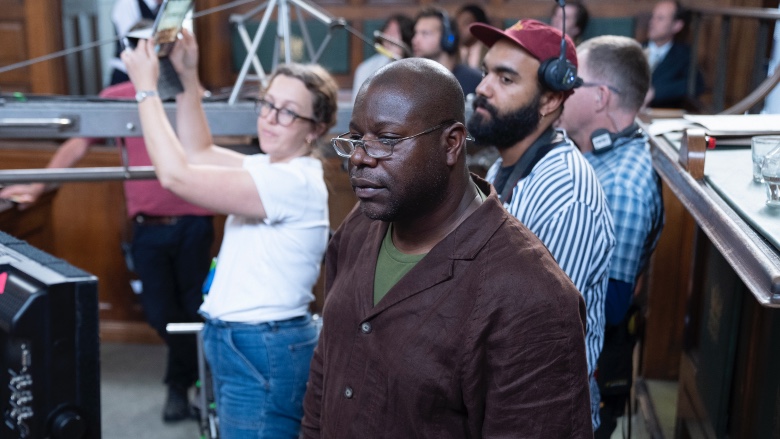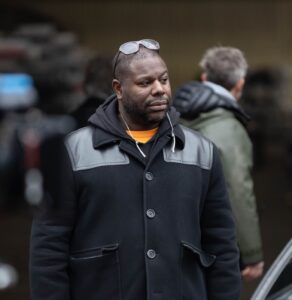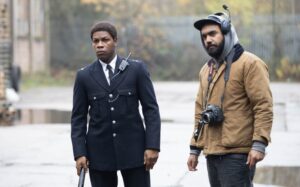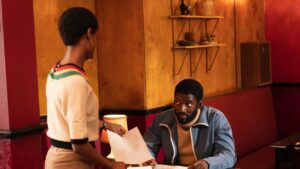
Throughout the ‘90s and early Aughts, filmmaker Steve McQueen was mostly known on the art scene for his short films and art installations. He had a huge breakout in 2008 when his debut feature Hunger debuted at the Cannes Film Festival. Starring McQueen’s frequent collaborator Michael Fassbender as Bobby Sands, the film dealt with the IRA member’s 1981 hunger strike, and it won McQueen the Camera d’Or for a first-time director, also making him the first British filmmaker to receive that honor.
Five years later, McQueen’s status took quite a great leap forward when his adaptation of the 1853 autobiography, 12 Years a Slave, won the Academy Award for Best Picture, earning McQueen his first Oscar for co-producing the picture. (He also received another nomination for his direction.)
The Small Axe Anthology might be McQueen’s most ambitious project to date, five separate but inter-connected films about the troubled history between the West Indian community and the London police from the late-‘60s and mid-‘80s. The series, which got its title a lyric in Bob Marley’s song Small Axe, was made in conjunction with the BBC and Amazon, who will release one film a week over the next month.
The first of the movies, Mangrove, tells the story of Frank Crichlow, the owner of a West Indian restaurant called the Mangrove in the late ‘60s, whose establishment is constantly rousted by the local police. With the help of Black Panther leader Altheia Jones (Letitia Wright), the community stages a protest that leads to police-driven violence and arrests.
The second film, Lovers Rock, follows the lead-up and events of a wild West London house party that helps bring the community together. Red, White and Blue, starring John Boyega, tells the true story of Leroy Logan, whose attempts to join the Metropolitan Police in order to reduce the racial profiling against his community creates other issues. Those three movies premiered at the New York Film Festival in September, while the last two films, Alex Wheatle and Education, will join them on Amazon Prime Video.
Despite being historical stories, the films in Small Axe Anthology are incredibly timely and relevant to what is happening in the United States right now with the reaction to the killings of George Floyd and Breonna Taylor. It’s also an amazing spotlight for the creative craft people that McQueen chose to collaborate with.

Below the Line had the pleasure of getting on a Zoom call with Mr. McQueen a few weeks back to talk about the origins of Small Axe, and how he worked with various department heads to recreate British history.
Below the Line: How was Small Axe conceived as a five-movie anthology? Was that the idea from the very beginning or did it evolve into that?
Steve McQueen: It kind of evolved from that, because I wanted to make… at first I thought it would be a television series going from 1968 to ‘84, about a West Indian family, but there were so many stories, so many things I wanted to talk about, and to get people to experience that I thought the best thing to do was make it into five feature films, because they’re each individual stories. I thought it was that important to show how the West Indian community influenced the culture of the United Kingdom.
BTL: I’m assuming you were probably very young when some of these stories happened. Were you aware of some of them?
McQueen: I wasn’t even born when the Mangrove started in ‘68, but Rhodan Gordon, one of the Mangrove Nine, was the best friend of my father. At the same time, this was all happening around me — it was in my DNA really.
BTL: What was the production timeline for making these five movies from saying, “Okay, we’re going to do this,” writing it, being on set and then finished.
McQueen: Eleven years from the initial wanting it to completion. Again, it went through a lot of reverberations, through TV and the writers’ rooms. In fact, the writers room actually became an audition for the writers I wanted to work with on the five scripts. It was a process, that’s for sure.
BTL: When were you on set shooting, and was filming ongoing as you finished scripts? Were you filming these around doing the other films?
McQueen: I can’t go in and out of films. I can in my mind, but once we start something as we would with physical production, it was from beginning to end. We started last year — I think we started shooting in February or March all the way into the summer.
BTL: And you used the same crew and department heads for the entire thing?
McQueen: There were slight changes, but not that many changes. Shabier [Kirchner], my DP, went all the way through. I mean, everyone went all the way through with one or two changes, that was it. It was the same group of people, really. It was one of those situations where I wanted to keep hold of that talent, because again, we were on a journey — we were definitely a crew.
BTL: I want to talk first about working with Production Design and Costume, because doing historical films like these is amazing, but even in Mangrove, there are so many different periods and sequences and styles of clothing seen.
McQueen: Working with Jacqueline Durran, Costume, and Helen Scott, the Production Designer, that was a great combination. To me, what was interesting about those two is that they’re artists. Again, you have these conversations, but when you’re doing five films back-to-back, and you’re dealing with all those things. Their achievement is there to see on screen, but also the fact that they were doing five feature films, one after the other, back-to-back. It’s pretty evident what they did and how they did it, as you’ve seen three of them.

BTL: Just the differences in the looks between the three films I’ve seen was impressive.
McQueen: Like I said, Shabier Kirchner, my new DP. I worked with Sean Bobbitt for thirteen years, and Sean unfortunately couldn’t make it this time, but finding Shabier was very fortunate at the same time. They actually had a conversation before Sean had to go off to America to start shooting. Working on different film stocks, from 35 to digital to 16, was very important, because again, what did each episode, what did each story demand? What do they need? What was the texture? What was the smell? What was the air needed? It’s very interesting when you see something that for audiences, it becomes subliminal to them. They don’t see that, but they actually feel it, and that’s what it’s about, getting it right, the images. With Shabier, he is extraordinary in the sense of balance. He has some of the best hands I’ve ever seen, as far as handheld, but also his camera crew were extraordinary, too. It’s one of those things where you have that wonderful environment where people realize that everyone is up for it and more risks can be taken. We’re family. We help each other. Everyone’s got an opinion.
BTL: I had been wondering about whether you had the budget to go the film route, since this was conceived as a television series.
McQueen: Well, you never have the budget, but you have the will, right? [Laughs] By hook or by crook, beg, borrow or steal, so that’s what it’s about. Also, I think that’s what it’s about being European filmmakers, often you don’t have enough money but you have a big imagination, where a lot of people don’t. When you don’t have money, you seem to have a little bit more freedom somehow, so that’s what happened in the end. Working on 35 for example on Mangrove and having a situation where I wanted a sort of monochrome look, and the whole idea of thinking of Gordon Parks’ photography, that was interesting as far as the colors were concerned. Also, for example, Lovers Rock was digital, because I wanted it to be alive. There’s a situation where there were very, very long takes in that situation where you didn’t want to cut. You want to have a sort of flow, like the music would flow, like rivers would flow, so that’s what it was about. That fluidity, this whole idea of being liquid in a way. That’s the digital situation with Lovers Rock. In 16mm, we did Education. We had a lot of TV shows in the UK, which were called Plays for Today. They were basically feature films that happened every week for a season on the BBC, and they were all shot on 16mm with the grain and the texture. I wanted to reimagine those images. Again, not a lot of people would think about that when they look at this, but it adds to the quality of the narrative.
BTL: On second viewing of Lovers Rock, I started noticing things like the unique lighting. Most of that movie is set inside a house but with very specific lighting for the period and not brightly lit. It made me wonder how you researched how the homes in which they had those parties looked?
McQueen: A lot of that was also helped by Tom Poole, my Colorist. I’ve been working with Tom since 12 Years. He’s an amazing colorist, and him and Shabier and myself worked on that. The lighting was very that [being] natural, because when I went to those parties, those Blues nights, they’re often lit by one light bulb or none, or just by the DJ decks, so few lights, because it was all about the mood and basically making that work. We needed to see something, but at the same time, we needed to imagine a lot, too.
BTL: I assume you did a lot of the post for these movies in the last 8 months during the pandemic, so how has that been going. Was it easy to adjust to those changes?
McQueen: It was good. It was myself and Chris Dickens, who edited it. He was in London, and I was in Amsterdam, and we worked with Lip Sync in London who are amazing people, especially the two men I worked with on the VFX, they were incredible. In some ways, it was vital that I had that communication with them on Zoom, because there wasn’t a lot of people during that time in lockdown to communicate with, so we would always empty our handbags at the beginning of a conversation or session. “How are you doing? What’s going on?” We were family, and what was wonderful was that we’re working together, too. In some ways, you get the best results often, but in this case, it was a lifeline in a way, because we were fortunate due to the amount of time we had in lockdown.
BTL: I’m glad you mentioned VFX. It’s one of those things in historical movies like these that you don’t often notice them. I remember speaking to Mike Leigh for his movie Peterloo, and I was shocked by how well the VFX integrated into the locations, because it looked so natural as if they had done all of it in-camera.
McQueen: Well, there’s not a lot. The VFX was more taking things out rather than adding people or anything like that. Actually, it was more about taking out certain contemporary things, but mostly doing things that we needed to take out. It was much more stuff like that than anything dramatic. Whether we had massive crowd scenes, we would have had problems, because of course, we’re making a film about things that were happening in the early ‘80s, so it wasn’t too much of an issue.

BTL: I also want to ask about working with Mika Levi on the score s we and whether she was able to do any of her recording before the lockdown took place.
McQueen: Afterwards. The score that she did was for Mangrove. The rest was archival and music like that that I had picked. Mika was absolutely amazing in how she ramped up the demonstration and whatnot. She’s a natural at bringing a certain kind of organic-ness to a situation that doesn’t seem foreign. It feels very much a part of the images.
BTL: When I focused on the more technical aspects of the film, it seemed like there could have been many challenges to face even something seemingly simple like the dance party in Lovers Rock where you had a DJ live-toasting, and then you have all the acapella singing. It’s really amazing how natural it all feels.
McQueen: The sound was very important, how we got that, and how that was choreographed. That was a lot to do with my two Sound Engineers in post, James [Harrison, Sound Effects Editor and Re-Recording Mixer] and Paul [Cotterell, Dialogue Editor and Re-Recording Mixer], who were amazing. [It was] absolutely incredible what they did and how they did it. The recording was amazing, too.
BTL: Those times in the late ‘70s and early ‘80s where punk, ska and reggae were all merging together with the latter influencing London rock musicians. Did you have any trouble getting the songs you wanted? Had you made a pretty big list of songs while you were writing the movies?
McQueen: No, I mean, yes and no. There were some songs that we couldn’t find the person for, but we found better alternatives, very few. There maybe was one or two, if that. I’d usually find one that was better than the one I thought I wanted in the first place. The guys who were involved with the music were just incredible also.
BTL: How are things going on the last two movies? Are you still in post?
McQueen: Generally, very well. We have two movies that we’re a nip and a tuck away, which is fantastic. Lip Sync and the pair there have been brilliant, and of course, Chris Dickens has been amazing with what he’s been doing, which is great. We have an amazing Assistant Editor, George Adams, who has been amazing too. He’s been the glue in our post-production, absolutely, no ifs, buts or maybes about it.
BTL: Before we wrap up, I do want to ask you something a little more vague in terms of how one looks at Small Axe as a series of movies, although they’re being presented as episodes of a series being shown on TV. Personally, I think if you only made Mangrove, that might be the best movie of the year even without the context of the others. The first three movies played at the New York Film Festival but the entire series will be streaming.
McQueen: You’re the critic. I just make the stuff, so I don’t really care. I do love cinema, I gotta say. You’re watching the movie with other people, the viewing is such an amazing experience. I mean, we’ve been doing it since we were sitting around campfires telling each other stories, and there’s nothing better than hearing the “oohs” and the “ahhs” and the screams and the laughter in an audience. That experience is thrilling. Could you imagine going on a roller coaster on your own? It wouldn’t be the same. Half of the fun is being thrilled with other people, and that’s what cinema is. I love cinema. As far as the bane of streaming cinema is concerned, look, all I can say is that once this pandemic is over, pray God as soon as possible, there will be an avalanche, a cascade of people going to the cinema. I think people will be going in droves, because people want to go out and experience things with other people. That’s who we are as human beings.

BTL: Were you able to come over here for any of the drive-ins at the New York Film Festival?
McQueen: No, no, no, I couldn’t because I was also working on the [other films] but I’d have to do a two-week curfew there and a two-week curfew coming back, so I didn’t unfortunately. I’d have to have been there two weeks in advance.
BTL: Have you had a chance to see any of the movies with an audience?
McQueen: I was in Rome to see Lovers Rock, and I saw Red, White and Blue… oh, I saw all three of them – one in London and then two in Rome.
BTL: I hope that Small Axe will be seen in the States because there’s so little we know about British history. What can you say about the final two films and how they fit into the anthology?
McQueen: Again, all these histories change nations, so that’s what I wanted to say. It’s not just about an aspect of the lives — it’s about how those lives changed the actual country. Anyway, the other two are Alex Wheatle, which is about this character named Alex Wheatle who grows up in children’s home where he’s left by his parents, and how he basically manages to fend for himself when he’s dropped off at 15-years-old in Brixton in the late ‘70s. By the early ‘80s, he ends up in prison, and his story about how he becomes an award-winning novelist. And then there is Education, which is a story about this child that’s roughly about my own journey through education in the UK, but we’re placing it in 1973, when children were sent off to these schools called “Educated Subnormal Schools,” so it’s an amalgamation of all my education in the ‘80s and what happened in the early ‘70s.
Mangrove is now available on Amazon Prime Video, and it will be joined by Lovers Rock on Friday, November 27, then Red, White and Blue on December 4, Alex Wheatle on December 11, and finally Education on December 18.





